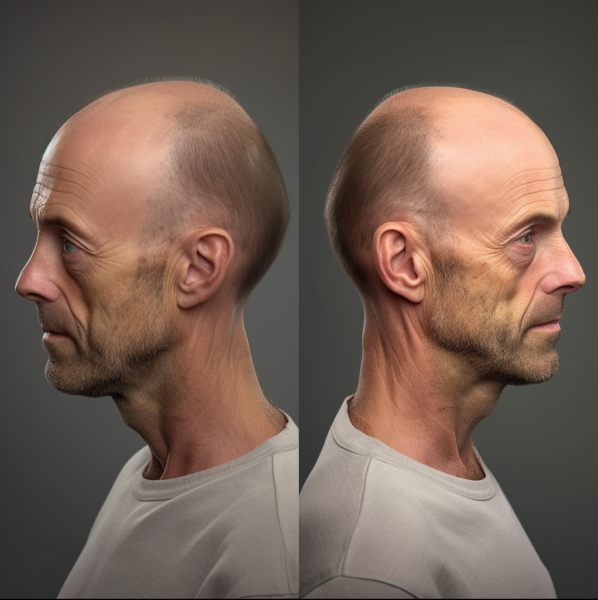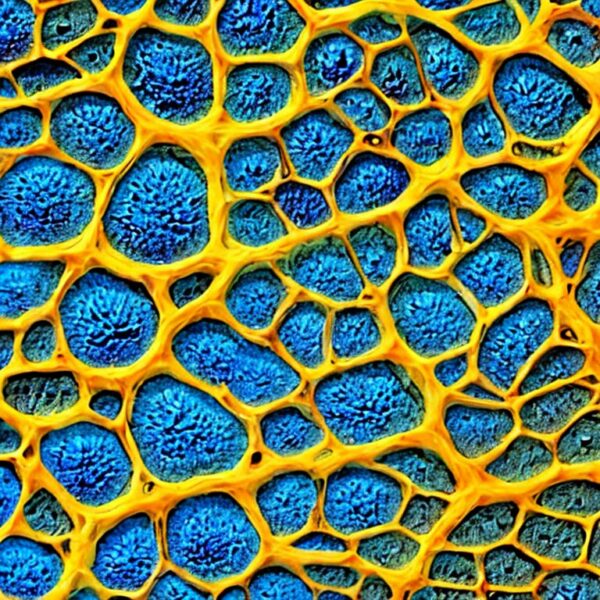Hair loss, or alopecia, is a common phenomenon affecting millions of individuals worldwide. While it is widely known that genetics and hormones play a significant role in hair loss, recent research has aimed at elucidating the intricate mechanisms involved in the variation of hair loss among different individuals. This article delves into the factors contributing to why some people experience more extensive hair loss than others.
The Role of Enzymes in Hair Loss: Sawaya provided evidence that there are differences in the concentration of enzymes, notably 5 alpha-reductase, in the skin and hair follicles of people with androgenetic alopecia, a common form of hair loss in both men and women. This enzyme converts testosterone into dihydrotestosterone (DHT), a potent androgen that is associated with hair follicle miniaturization and hair loss. Individuals with higher concentrations of 5 alpha-reductase are likely to convert more testosterone into DHT, which may lead to more extensive androgenetic alopecia.
Sensitivity of Androgen Receptors: In addition to the concentration of enzymes, the sensitivity of androgen receptors in hair follicles has been identified as a factor influencing the extent of hair loss. Greater sensitivity of these receptors in some individuals implies that a certain concentration of androgens may promote much more hair loss than a similar concentration in someone with less sensitive receptors. This difference in sensitivity can be attributed to genetic predispositions and epigenetic modifications affecting the androgen receptor genes.
Genetic Predisposition: A major factor influencing both the levels of 5 alpha-reductase and the sensitivity of androgen receptors is genetics. Polymorphisms in the genes encoding these enzymes and receptors have been associated with differences in hair loss patterns. For instance, variations in the AR gene, which encodes the androgen receptor, have been linked to the development and progression of androgenetic alopecia. Additionally, the gene encoding 5 alpha-reductase, SRD5A2, has been implicated in the predisposition to hair loss. Slight variations of these genes in different people can result in significantly different levels of hair loss development.
Hormonal Fluctuations and Imbalances: Hormonal levels, especially of androgens, play a critical role in hair loss. Elevated levels of DHT due to hormonal imbalances or external factors such as medication, can exacerbate hair loss. Women experiencing menopause, for instance, undergo hormonal changes that can lead to hair thinning and loss. Furthermore, conditions such as Polycystic Ovary Syndrome (PCOS) in women can cause an increase in androgen levels, contributing to hair loss.
Inflammation and Hair Follicle Miniaturization: Chronic inflammation has been identified as a factor that contributes to hair loss. Inflammation around the hair follicles can lead to follicle miniaturization, a process where the hair follicle shrinks over time. This shrinkage leads to the production of thinner, shorter hairs. Moreover, inflammation can cause fibrosis (scar tissue formation) around hair follicles, which further aggravates hair loss by impeding blood flow and nutrient delivery to the follicles.
Environmental Factors and Lifestyle Choices: Environmental factors such as pollution, smoking, and exposure to harsh chemicals can negatively affect hair health. For instance, cigarette smoke is known to cause oxidative stress which can damage hair follicles. Moreover, lifestyle choices such as diet and stress levels can influence hair loss. A diet lacking in essential nutrients like biotin, zinc, and protein can weaken hair, while a diet that includes a high level of red meat may increase the level of androgen hormone production. Equally, chronic stress can alter hormone levels and exacerbate hair loss.
Future Directions: Understanding the multifactorial nature of hair loss is crucial for the development of targeted therapies. Advances in genetic testing and molecular biology enable a personalized approach to hair loss treatment. By identifying the underlying genetic susceptibilities and monitoring enzyme levels and receptor sensitivities, treatments can be tailored to an individual’s specific needs. This might include combinations of pharmacological interventions targeting 5 alpha-reductase and androgen receptors, as well as lifestyle modifications and anti-inflammatory therapies.
In conclusion, the extent of hair loss among individuals is governed by a myriad of factors including enzyme concentrations, receptor sensitivities, genetic predispositions, hormonal fluctuations, inflammation, and environmental factors. It is the interplay between these factors that determines the pattern and severity of hair loss. Future research and treatments should focus on a holistic approach, considering the complex nature of hair loss and the variation among individuals. Through personalized medicine and a greater understanding of the molecular mechanisms involved, it is hoped that more effective strategies for managing and treating hair loss will be developed.
Bibliography
11711645 {11711645:AVKNUEWU},{11711645:P9B2X6PR},{11711645:2JR2WPAQ},{11711645:DWC3ZWNR},{11711645:GHWPGVC2},{11711645:MENIK27I},{11711645:NQ6NAITF},{11711645:9HKDJ3A6},{11711645:G7E96C5A},{11711645:MG6NQMTM},{11711645:MX8CT5G4},{11711645:AZBAQCZ2},{11711645:SSU75CE9} 1 vancouver 50 date asc 242 https://www.keratin.com/wp-content/plugins/zotpress/ %7B%22status%22%3A%22success%22%2C%22updateneeded%22%3Afalse%2C%22instance%22%3Afalse%2C%22meta%22%3A%7B%22request_last%22%3A0%2C%22request_next%22%3A0%2C%22used_cache%22%3Atrue%7D%2C%22data%22%3A%5B%7B%22key%22%3A%22MENIK27I%22%2C%22library%22%3A%7B%22id%22%3A11711645%7D%2C%22meta%22%3A%7B%22creatorSummary%22%3A%22Randall%20et%20al.%22%2C%22parsedDate%22%3A%221992-06%22%2C%22numChildren%22%3A0%7D%2C%22bib%22%3A%22%3Cdiv%20class%3D%5C%22csl-bib-body%5C%22%20style%3D%5C%22line-height%3A%201.35%3B%20%5C%22%3E%5Cn%20%20%3Cdiv%20class%3D%5C%22csl-entry%5C%22%20style%3D%5C%22clear%3A%20left%3B%20%5C%22%3E%5Cn%20%20%20%20%3Cdiv%20class%3D%5C%22csl-left-margin%5C%22%20style%3D%5C%22float%3A%20left%3B%20padding-right%3A%200.5em%3B%20text-align%3A%20right%3B%20width%3A%201em%3B%5C%22%3E1.%3C%5C%2Fdiv%3E%3Cdiv%20class%3D%5C%22csl-right-inline%5C%22%20style%3D%5C%22margin%3A%200%20.4em%200%201.5em%3B%5C%22%3ERandall%20VA%2C%20Thornton%20MJ%2C%20Hamada%20K%2C%20Messenger%20AG.%20Mechanism%20of%20androgen%20action%20in%20cultured%20dermal%20papilla%20cells%20derived%20from%20human%20hair%20follicles%20with%20varying%20responses%20to%20androgens%20in%20vivo.%20J%20Invest%20Dermatol.%201992%20Jun%3B98%286%20Suppl%29%3A86S-91S.%3C%5C%2Fdiv%3E%5Cn%20%20%20%3C%5C%2Fdiv%3E%5Cn%3C%5C%2Fdiv%3E%22%2C%22data%22%3A%7B%22itemType%22%3A%22journalArticle%22%2C%22title%22%3A%22Mechanism%20of%20androgen%20action%20in%20cultured%20dermal%20papilla%20cells%20derived%20from%20human%20hair%20follicles%20with%20varying%20responses%20to%20androgens%20in%20vivo%22%2C%22creators%22%3A%5B%7B%22creatorType%22%3A%22author%22%2C%22firstName%22%3A%22V.%20A.%22%2C%22lastName%22%3A%22Randall%22%7D%2C%7B%22creatorType%22%3A%22author%22%2C%22firstName%22%3A%22M.%20J.%22%2C%22lastName%22%3A%22Thornton%22%7D%2C%7B%22creatorType%22%3A%22author%22%2C%22firstName%22%3A%22K.%22%2C%22lastName%22%3A%22Hamada%22%7D%2C%7B%22creatorType%22%3A%22author%22%2C%22firstName%22%3A%22A.%20G.%22%2C%22lastName%22%3A%22Messenger%22%7D%5D%2C%22abstractNote%22%3A%22Androgens%20are%20major%20regulators%20of%20human%20hair%20growth%2C%20but%20their%20effects%20vary%3A%20many%20follicles%20are%20stimulated%20by%20androgens%2C%20e.g.%2C%20beard%3B%20some%20remain%20unaffected%2C%20e.g.%2C%20eyelashes%3B%20whereas%20scalp%20follicles%20undergo%20regression%20and%20balding%20in%20genetically%20disposed%20individuals.%20Because%20the%20dermal%20papilla%20controls%20many%20aspects%20of%20the%20hair%20follicle%2C%20androgens%20may%20act%20via%20the%20dermal%20papilla%2C%20affecting%20the%20other%20follicular%20components%20indirectly.%20In%20this%20hypothesis%20androgens%20would%20alter%20dermal%20papilla%20cell%20production%20of%20regulatory%20substances%2C%20e.g.%2C%20growth%20factors%20and%5C%2For%20extracellular%20matrix%20components.%20To%20test%20this%20theory%20the%20mechanism%20of%20androgen%20action%20has%20been%20compared%20in%20primary%20lines%20of%20dermal%20papilla%20cells%20cultured%20from%20androgen-dependent%20follicles%20and%20relatively%20androgen-independent%20non-balding%20scalp.%20Androgen%20receptor%20levels%20were%20assayed%20by%20saturation%20analysis%20%289-10%20points%3B%200.05-10%20nmol%5C%2Fl%29%20using%20the%20synthetic%20androgen%20%5B3H%5D-mibolerone%20and%20specificity%20was%20confirmed%20by%20competition%20studies.%20Androgen%20metabolism%20was%20investigated%20both%20intracellularly%20and%20in%20the%20media%20after%20a%202-h%20incubation%20with%205%20nM%20%5B3H%5D-testosterone.%20Carrier%20and%20%5B14C%5D%20steroids%20were%20added%20to%20the%20extracts%20before%20separation%20by%20thin-layer%20chromatography%3B%20steroid%20identity%20was%20confirmed%20by%20recrystallization.%20Dermal%20papilla%20cells%20from%20androgen-dependent%20follicles%20contained%20higher%20levels%20of%20specific%2C%20high-affinity%2C%20low-capacity%20androgen%20receptors%20than%20non-balding%20scalp%20cells.%20Testosterone%20metabolism%20also%20varied%20with%20beard%2C%20public%20and%20scalp%20cells%20containing%20testosterone%20and%20androstenedione%20intracellularly%2C%20but%20only%20beard%20cells%20producing%205%20alpha-dihydrotestosterone%2C%20in%20line%20with%20the%20scanty%20beard%20growth%20found%20in%205%20alpha-reductase%20deficiency.%20Elsewhere%20we%20have%20shown%20that%20cultured%20dermal%20papilla%20cells%20produce%20extracellular%20matrix%20components%20and%20mitogenic%20factors.%20These%20results%20all%20concur%20with%20our%20original%20hypothesis%20and%20suggest%20that%20further%20studies%20of%20such%20cells%20may%20elucidate%20the%20paradoxical%20effects%20of%20androgens%20on%20human%20hair%20follicles.%22%2C%22date%22%3A%221992-06%22%2C%22language%22%3A%22eng%22%2C%22DOI%22%3A%2210.1111%5C%2F1523-1747.ep12462307%22%2C%22ISSN%22%3A%220022-202X%22%2C%22url%22%3A%22%22%2C%22collections%22%3A%5B%22EAHTHCG4%22%5D%2C%22dateModified%22%3A%222023-06-25T15%3A04%3A06Z%22%7D%7D%2C%7B%22key%22%3A%22MX8CT5G4%22%2C%22library%22%3A%7B%22id%22%3A11711645%7D%2C%22meta%22%3A%7B%22creatorSummary%22%3A%22Liu%20et%20al.%22%2C%22parsedDate%22%3A%221997%22%2C%22numChildren%22%3A0%7D%2C%22bib%22%3A%22%3Cdiv%20class%3D%5C%22csl-bib-body%5C%22%20style%3D%5C%22line-height%3A%201.35%3B%20%5C%22%3E%5Cn%20%20%3Cdiv%20class%3D%5C%22csl-entry%5C%22%20style%3D%5C%22clear%3A%20left%3B%20%5C%22%3E%5Cn%20%20%20%20%3Cdiv%20class%3D%5C%22csl-left-margin%5C%22%20style%3D%5C%22float%3A%20left%3B%20padding-right%3A%200.5em%3B%20text-align%3A%20right%3B%20width%3A%201em%3B%5C%22%3E1.%3C%5C%2Fdiv%3E%3Cdiv%20class%3D%5C%22csl-right-inline%5C%22%20style%3D%5C%22margin%3A%200%20.4em%200%201.5em%3B%5C%22%3ELiu%20CS%2C%20Kao%20SH%2C%20Wei%20YH.%20Smoking-associated%20mitochondrial%20DNA%20mutations%20in%20human%20hair%20follicles.%20Environ%20Mol%20Mutagen.%201997%3B30%281%29%3A47%26%23x2013%3B55.%3C%5C%2Fdiv%3E%5Cn%20%20%20%3C%5C%2Fdiv%3E%5Cn%3C%5C%2Fdiv%3E%22%2C%22data%22%3A%7B%22itemType%22%3A%22journalArticle%22%2C%22title%22%3A%22Smoking-associated%20mitochondrial%20DNA%20mutations%20in%20human%20hair%20follicles%22%2C%22creators%22%3A%5B%7B%22creatorType%22%3A%22author%22%2C%22firstName%22%3A%22C.%20S.%22%2C%22lastName%22%3A%22Liu%22%7D%2C%7B%22creatorType%22%3A%22author%22%2C%22firstName%22%3A%22S.%20H.%22%2C%22lastName%22%3A%22Kao%22%7D%2C%7B%22creatorType%22%3A%22author%22%2C%22firstName%22%3A%22Y.%20H.%22%2C%22lastName%22%3A%22Wei%22%7D%5D%2C%22abstractNote%22%3A%22The%20mitochondrial%20DNA%20%28mtDNA%29%20of%20hair%20follicles%20was%20used%20for%20studying%20the%20genotoxicity%20of%20smoking-mediated%20carcinogens.%20We%20determined%20the%20incidences%20of%20the%204%2C977%20bp%20and%207%2C436%20bp%20mtDNA%20deletions%2C%20tandem%20duplication%20in%20the%20D-loop%20region%20and%20the%20proportion%20of%20the%204%2C977%20bp%20deleted%20mtDNA%20%28dmtDNA%29%20in%20the%20total%20DNA%20of%20hair%20follicles%20from%20213%20male%20non-smokers%20and%2074%20male%20smokers%2C%20respectively.%20Twenty-three%20patients%20with%20lung%20cancer%20were%20also%20investigated.%20We%20found%20that%20the%20current%20cigarette%20smokers%20had%20a%203.1%20times%20higher%20average%20incidence%20of%20the%204%2C977%20bp%20dmtDNA%20%28RR%3A%203.1%2C%20P%20%3C%200.001%29%20as%20compared%20with%20non-smokers%2C%20and%20this%20mtDNA%20deletion%20was%20especially%20prevalent%20in%20the%20old%20heavy%20smokers.%20For%20the%20smokers%20of%20the%20age%20above%2070%2C%20the%20average%20incidence%20of%20the%204%2C977%20bp%20dmtDNA%20was%203.7%20times%20higher%20in%20the%20group%20with%20a%20smoking%20index%20of%20401-800%20%28RR%3A%203.7%2C%20P%20%3C%200.005%29%20and%203.2%20times%20higher%20in%20the%20group%20with%20a%20smoking%20index%20greater%20than%20800%20%28RR%3A%203.2%2C%20P%20%3C%200.005%29.%20However%2C%20there%20was%20no%20statistically%20significant%20relationship%20between%20the%20incidence%20of%20the%207%2C436%20bp%20dmtDNA%20and%20the%20smoking%20index%2C%20although%20there%20was%20a%20mild%20increase%20in%20the%20percentage%20of%20the%207%2C436%20bp%20dmtDNA%20with%20the%20increase%20of%20the%20consumption%20of%20cigarettes.%20No%20tandem%20duplication%20of%20mtDNA%20in%20the%20D-loop%20region%20was%20disclosed%20in%20either%20smokers%20or%20non-smokers%20group.%20The%20proportions%20of%20the%204%2C977%20bp%20dmtDNA%20in%20hair%20follicles%20were%20found%20to%20correlate%20with%20age%2C%20but%20did%20not%20keep%20increasing%20with%20cigarette%20consumption%20except%20in%20the%20group%20of%20subjects%20with%20a%20smoking%20index%20of%20less%20than%20400.%20On%20the%20other%20hand%2C%20we%20found%20that%20the%20average%20proportion%20of%20the%204%2C977%20bp%20dmtDNA%20in%20the%20hair%20follicles%20was%201.201%20%2B%5C%2F-%200.371%25%20for%20the%20patients%20with%20lung%20cancer%20who%20had%20a%20smoking%20index%20greater%20than%20400%2C%20while%20that%20was%20only%200.146%25%20for%20the%20age-matched%20healthy%20smokers%20with%20the%20same%20smoking%20index.%20In%20conclusion%2C%20the%20high%20incidence%20of%20the%204%2C977%20bp%20dmtDNA%20of%20hair%20follicles%20is%20not%20only%20associated%20with%20aging%20but%20also%20correlated%20with%20the%20amount%20of%20cigarette%20smoking.%20A%20high%20proportion%20of%20the%204%2C977%20bp%20dmtDNA%20in%20the%20hair%20follicles%20may%20be%20considered%20one%20of%20the%20molecular%20events%20that%20are%20associated%20with%20the%20occurrence%20of%20smoking-associated%20cancers.%22%2C%22date%22%3A%221997%22%2C%22language%22%3A%22eng%22%2C%22DOI%22%3A%2210.1002%5C%2F%28sici%291098-2280%281997%2930%3A1%3C47%3A%3Aaid-em7%3E3.0.co%3B2-9%22%2C%22ISSN%22%3A%220893-6692%22%2C%22url%22%3A%22%22%2C%22collections%22%3A%5B%22EAHTHCG4%22%5D%2C%22dateModified%22%3A%222023-06-25T15%3A18%3A30Z%22%7D%7D%2C%7B%22key%22%3A%22DWC3ZWNR%22%2C%22library%22%3A%7B%22id%22%3A11711645%7D%2C%22meta%22%3A%7B%22creatorSummary%22%3A%22Sawaya%22%2C%22parsedDate%22%3A%221997-01%22%2C%22numChildren%22%3A0%7D%2C%22bib%22%3A%22%3Cdiv%20class%3D%5C%22csl-bib-body%5C%22%20style%3D%5C%22line-height%3A%201.35%3B%20%5C%22%3E%5Cn%20%20%3Cdiv%20class%3D%5C%22csl-entry%5C%22%20style%3D%5C%22clear%3A%20left%3B%20%5C%22%3E%5Cn%20%20%20%20%3Cdiv%20class%3D%5C%22csl-left-margin%5C%22%20style%3D%5C%22float%3A%20left%3B%20padding-right%3A%200.5em%3B%20text-align%3A%20right%3B%20width%3A%201em%3B%5C%22%3E1.%3C%5C%2Fdiv%3E%3Cdiv%20class%3D%5C%22csl-right-inline%5C%22%20style%3D%5C%22margin%3A%200%20.4em%200%201.5em%3B%5C%22%3ESawaya%20ME.%20Clinical%20updates%20in%20hair.%20Dermatol%20Clin.%201997%20Jan%3B15%281%29%3A37%26%23x2013%3B43.%3C%5C%2Fdiv%3E%5Cn%20%20%20%3C%5C%2Fdiv%3E%5Cn%3C%5C%2Fdiv%3E%22%2C%22data%22%3A%7B%22itemType%22%3A%22journalArticle%22%2C%22title%22%3A%22Clinical%20updates%20in%20hair%22%2C%22creators%22%3A%5B%7B%22creatorType%22%3A%22author%22%2C%22firstName%22%3A%22M.%20E.%22%2C%22lastName%22%3A%22Sawaya%22%7D%5D%2C%22abstractNote%22%3A%22It%20is%20now%20known%20that%20there%20are%20major%20differences%20in%20the%20systemic%20and%20cellular%20mechanisms%20that%20mediate%20hair%20loss%20in%20women%20versus%20men.%20The%20severity%20or%20degree%20of%20hair%20loss%20in%20women%20with%20androgenetic%20alopecia%20is%20usually%20much%20less%20than%20in%20men.%20It%20is%20usually%20assumed%20that%20the%20hormonal%20basis%20for%20androgenetic%20alopecia%20in%20women%20is%20the%20same%20as%20in%20men%3B%20that%20is%2C%20the%20same%20target%20tissue-active%20androgens%2C%20testosterone%20and%20dihydrotestosterone%2C%20are%20being%20produced%20systemically%20to%20aggravate%20scalp%20hair%20follicles%2C%20resulting%20in%20hair%20loss.%20This%20article%20reviews%20some%20of%20the%20latest%20findings%20in%20androgenetic%20alopecia%20for%20both%20men%20and%20women%2C%20along%20with%20new%20and%20old%20treatments%20and%20drugs%2C%20doses%2C%20and%20effectiveness.%20Research%20findings%20indicate%20that%20levels%20of%20androgen-metabolizing%20enzymes%20and%20receptors%20differ%20in%20the%20scalps%20of%20women%20versus%20men%2C%20which%20may%20be%20important%20in%20formulating%20more%20effective%20hair%20growth%20treatments%20in%20the%20future.%22%2C%22date%22%3A%221997-01%22%2C%22language%22%3A%22eng%22%2C%22DOI%22%3A%2210.1016%5C%2Fs0733-8635%2805%2970413-7%22%2C%22ISSN%22%3A%220733-8635%22%2C%22url%22%3A%22%22%2C%22collections%22%3A%5B%22EAHTHCG4%22%5D%2C%22dateModified%22%3A%222023-06-25T15%3A00%3A10Z%22%7D%7D%2C%7B%22key%22%3A%222JR2WPAQ%22%2C%22library%22%3A%7B%22id%22%3A11711645%7D%2C%22meta%22%3A%7B%22creatorSummary%22%3A%22Sawaya%20and%20Price%22%2C%22parsedDate%22%3A%221997-09%22%2C%22numChildren%22%3A0%7D%2C%22bib%22%3A%22%3Cdiv%20class%3D%5C%22csl-bib-body%5C%22%20style%3D%5C%22line-height%3A%201.35%3B%20%5C%22%3E%5Cn%20%20%3Cdiv%20class%3D%5C%22csl-entry%5C%22%20style%3D%5C%22clear%3A%20left%3B%20%5C%22%3E%5Cn%20%20%20%20%3Cdiv%20class%3D%5C%22csl-left-margin%5C%22%20style%3D%5C%22float%3A%20left%3B%20padding-right%3A%200.5em%3B%20text-align%3A%20right%3B%20width%3A%201em%3B%5C%22%3E1.%3C%5C%2Fdiv%3E%3Cdiv%20class%3D%5C%22csl-right-inline%5C%22%20style%3D%5C%22margin%3A%200%20.4em%200%201.5em%3B%5C%22%3ESawaya%20ME%2C%20Price%20VH.%20Different%20levels%20of%205alpha-reductase%20type%20I%20and%20II%2C%20aromatase%2C%20and%20androgen%20receptor%20in%20hair%20follicles%20of%20women%20and%20men%20with%20androgenetic%20alopecia.%20J%20Invest%20Dermatol.%201997%20Sep%3B109%283%29%3A296%26%23x2013%3B300.%3C%5C%2Fdiv%3E%5Cn%20%20%20%3C%5C%2Fdiv%3E%5Cn%3C%5C%2Fdiv%3E%22%2C%22data%22%3A%7B%22itemType%22%3A%22journalArticle%22%2C%22title%22%3A%22Different%20levels%20of%205alpha-reductase%20type%20I%20and%20II%2C%20aromatase%2C%20and%20androgen%20receptor%20in%20hair%20follicles%20of%20women%20and%20men%20with%20androgenetic%20alopecia%22%2C%22creators%22%3A%5B%7B%22creatorType%22%3A%22author%22%2C%22firstName%22%3A%22M.%20E.%22%2C%22lastName%22%3A%22Sawaya%22%7D%2C%7B%22creatorType%22%3A%22author%22%2C%22firstName%22%3A%22V.%20H.%22%2C%22lastName%22%3A%22Price%22%7D%5D%2C%22abstractNote%22%3A%22In%20this%20study%2C%2012%20women%20and%2012%20men%2C%20ages%2018-33%20y%2C%20with%20androgenetic%20alopecia%20were%20selected%20for%20biopsies%20from%20frontal%20and%20occipital%20scalp%20sites.%20The%20androgen%20receptor%2C%20type%20I%20and%20II%205alpha-reductase%2C%20cytochrome%20P-450-aromatase%20enzyme%20were%20measured%20and%20analyzed%20in%20hair%20follicles%20from%20these%20scalp%20biopsies.%20Findings%20revealed%20that%20both%20women%20and%20men%20have%20higher%20levels%20of%20receptors%20and%205alpha-reductase%20type%20I%20and%20II%20in%20frontal%20hair%20follices%20than%20in%20occipital%20follicles%2C%20whereas%20higher%20levels%20of%20aromatase%20were%20found%20in%20their%20occipital%20follicles.%20There%20are%20marked%20quantitative%20differences%20in%20levels%20of%20androgen%20receptors%20and%20the%20three%20enzymes%2C%20which%20we%20find%20to%20be%20primarily%20in%20the%20outer%20root%20sheath%20of%20the%20hair%20follicles%20in%20the%20two%20genders.%20Androgen%20receptor%20content%20in%20female%20frontal%20hair%20follicles%20was%20approximately%2040%25%20lower%20than%20in%20male%20frontal%20hair%20follicle.%20Cytochrome%20P-450-aromatase%20content%20in%20women%27s%20frontal%20hair%20follicles%20was%20six%20times%20greater%20than%20in%20frontal%20hair%20follicles%20in%20men.%20Frontal%20hair%20follicles%20in%20women%20had%203%20and%203.5%20times%20less%205alpha-reductase%20type%20I%20and%20II%2C%20respectively%2C%20than%20frontal%20hair%20follicles%20in%20men.%20These%20differences%20in%20levels%20of%20androgen%20receptor%20and%20steroid-converting%20enzymes%20may%20account%20for%20the%20different%20clinical%20presentations%20of%20androgenetic%20alopecia%20in%20women%20and%20men.%22%2C%22date%22%3A%221997-09%22%2C%22language%22%3A%22eng%22%2C%22DOI%22%3A%2210.1111%5C%2F1523-1747.ep12335779%22%2C%22ISSN%22%3A%220022-202X%22%2C%22url%22%3A%22%22%2C%22collections%22%3A%5B%22EAHTHCG4%22%5D%2C%22dateModified%22%3A%222023-06-25T15%3A00%3A23Z%22%7D%7D%2C%7B%22key%22%3A%22P9B2X6PR%22%2C%22library%22%3A%7B%22id%22%3A11711645%7D%2C%22meta%22%3A%7B%22creatorSummary%22%3A%22Hibberts%20et%20al.%22%2C%22parsedDate%22%3A%221998-01%22%2C%22numChildren%22%3A0%7D%2C%22bib%22%3A%22%3Cdiv%20class%3D%5C%22csl-bib-body%5C%22%20style%3D%5C%22line-height%3A%201.35%3B%20%5C%22%3E%5Cn%20%20%3Cdiv%20class%3D%5C%22csl-entry%5C%22%20style%3D%5C%22clear%3A%20left%3B%20%5C%22%3E%5Cn%20%20%20%20%3Cdiv%20class%3D%5C%22csl-left-margin%5C%22%20style%3D%5C%22float%3A%20left%3B%20padding-right%3A%200.5em%3B%20text-align%3A%20right%3B%20width%3A%201em%3B%5C%22%3E1.%3C%5C%2Fdiv%3E%3Cdiv%20class%3D%5C%22csl-right-inline%5C%22%20style%3D%5C%22margin%3A%200%20.4em%200%201.5em%3B%5C%22%3EHibberts%20NA%2C%20Howell%20AE%2C%20Randall%20VA.%20Balding%20hair%20follicle%20dermal%20papilla%20cells%20contain%20higher%20levels%20of%20androgen%20receptors%20than%20those%20from%20non-balding%20scalp.%20J%20Endocrinol.%201998%20Jan%3B156%281%29%3A59%26%23x2013%3B65.%3C%5C%2Fdiv%3E%5Cn%20%20%20%3C%5C%2Fdiv%3E%5Cn%3C%5C%2Fdiv%3E%22%2C%22data%22%3A%7B%22itemType%22%3A%22journalArticle%22%2C%22title%22%3A%22Balding%20hair%20follicle%20dermal%20papilla%20cells%20contain%20higher%20levels%20of%20androgen%20receptors%20than%20those%20from%20non-balding%20scalp%22%2C%22creators%22%3A%5B%7B%22creatorType%22%3A%22author%22%2C%22firstName%22%3A%22N.%20A.%22%2C%22lastName%22%3A%22Hibberts%22%7D%2C%7B%22creatorType%22%3A%22author%22%2C%22firstName%22%3A%22A.%20E.%22%2C%22lastName%22%3A%22Howell%22%7D%2C%7B%22creatorType%22%3A%22author%22%2C%22firstName%22%3A%22V.%20A.%22%2C%22lastName%22%3A%22Randall%22%7D%5D%2C%22abstractNote%22%3A%22Androgens%20can%20gradually%20transform%20large%20scalp%20hair%20follicles%20to%20smaller%20vellus%20ones%2C%20causing%20balding.%20The%20mechanisms%20involved%20are%20unclear%2C%20although%20androgens%20are%20believed%20to%20act%20on%20the%20epithelial%20hair%20follicle%20via%20the%20mesenchyme-derived%20dermal%20papilla.%20This%20study%20investigates%20whether%20the%20levels%20and%20type%20of%20androgen%20receptors%20in%20primary%20lines%20of%20cultured%20dermal%20papilla%20cells%20derived%20from%20balding%20scalp%20hair%20follicles%20differ%20from%20those%20of%20follicles%20from%20non-balding%20scalp.%20Androgen%20receptor%20content%20was%20measured%20by%20saturation%20analysis%20using%20the%20non-metabolisable%20androgen%2C%20%5B3H%5Dmibolerone%20%280.05-10%20nM%29%20in%20a%209-10%20point%20assay.%20Pubic%20dermal%20fibroblasts%20and%20Shionogi%20cells%20were%20examined%20as%20positive%20controls.%20Repetitive%20assays%20of%20Shionogi%20cells%20showed%20good%20precision%20in%20the%20levels%20of%20androgen%20receptor%20content%20%28coefficient%20of%20variation%20%3D%203.7%25%29.%20Specific%2C%20high%20affinity%2C%20low%20capacity%20androgen%20receptors%20were%20detected%20in%20dermal%20papilla%20cells%20from%20both%20balding%20and%20non-balding%20follicles.%20Balding%20cells%20contained%20significantly%20%28P%20%3C%200.01%29%20greater%20levels%20of%20androgen%20receptors%20%28Bmax%20%3D%200.06%20%2B%5C%2F-%200.01%20fmol%5C%2F10%284%29%20cells%20%28mean%20%2B%5C%2F-%20S.E.M.%29%29%20than%20those%20from%20non-balding%20scalp%20%280.04%20%2B%5C%2F-%200.001%29.%20Competition%20studies%20with%20a%20range%20of%20steroids%20showed%20no%20differences%20in%20receptor%20binding%20specificity%20in%20the%20two%20cell%20types.%20The%20higher%20levels%20of%20androgen%20receptors%20in%20cells%20from%20balding%20scalp%20hair%20follicles%20with%20similar%20properties%20to%20those%20from%20non-balding%20scalp%20concur%20with%20the%20expectations%20from%20their%20in%20vivo%20responses%20to%20androgens.%20This%20supports%20the%20hypothesis%20that%20androgens%20act%20via%20the%20dermal%20papilla%20and%20suggests%20that%20cultured%20dermal%20papilla%20cells%20may%20offer%20a%20model%20system%20for%20studying%20androgen%20action%20in%20androgenetic%20alopecia.%22%2C%22date%22%3A%221998-01%22%2C%22language%22%3A%22eng%22%2C%22DOI%22%3A%2210.1677%5C%2Fjoe.0.1560059%22%2C%22ISSN%22%3A%220022-0795%22%2C%22url%22%3A%22%22%2C%22collections%22%3A%5B%22EAHTHCG4%22%5D%2C%22dateModified%22%3A%222023-06-25T15%3A02%3A25Z%22%7D%7D%2C%7B%22key%22%3A%22AZBAQCZ2%22%2C%22library%22%3A%7B%22id%22%3A11711645%7D%2C%22meta%22%3A%7B%22creatorSummary%22%3A%22Ellis%20et%20al.%22%2C%22parsedDate%22%3A%222001-03%22%2C%22numChildren%22%3A0%7D%2C%22bib%22%3A%22%3Cdiv%20class%3D%5C%22csl-bib-body%5C%22%20style%3D%5C%22line-height%3A%201.35%3B%20%5C%22%3E%5Cn%20%20%3Cdiv%20class%3D%5C%22csl-entry%5C%22%20style%3D%5C%22clear%3A%20left%3B%20%5C%22%3E%5Cn%20%20%20%20%3Cdiv%20class%3D%5C%22csl-left-margin%5C%22%20style%3D%5C%22float%3A%20left%3B%20padding-right%3A%200.5em%3B%20text-align%3A%20right%3B%20width%3A%201em%3B%5C%22%3E1.%3C%5C%2Fdiv%3E%3Cdiv%20class%3D%5C%22csl-right-inline%5C%22%20style%3D%5C%22margin%3A%200%20.4em%200%201.5em%3B%5C%22%3EEllis%20JA%2C%20Stebbing%20M%2C%20Harrap%20SB.%20Polymorphism%20of%20the%20androgen%20receptor%20gene%20is%20associated%20with%20male%20pattern%20baldness.%20J%20Invest%20Dermatol.%202001%20Mar%3B116%283%29%3A452%26%23x2013%3B5.%3C%5C%2Fdiv%3E%5Cn%20%20%20%3C%5C%2Fdiv%3E%5Cn%3C%5C%2Fdiv%3E%22%2C%22data%22%3A%7B%22itemType%22%3A%22journalArticle%22%2C%22title%22%3A%22Polymorphism%20of%20the%20androgen%20receptor%20gene%20is%20associated%20with%20male%20pattern%20baldness%22%2C%22creators%22%3A%5B%7B%22creatorType%22%3A%22author%22%2C%22firstName%22%3A%22J.%20A.%22%2C%22lastName%22%3A%22Ellis%22%7D%2C%7B%22creatorType%22%3A%22author%22%2C%22firstName%22%3A%22M.%22%2C%22lastName%22%3A%22Stebbing%22%7D%2C%7B%22creatorType%22%3A%22author%22%2C%22firstName%22%3A%22S.%20B.%22%2C%22lastName%22%3A%22Harrap%22%7D%5D%2C%22abstractNote%22%3A%22The%20common%20heritable%20loss%20of%20scalp%20hair%20known%20as%20male%20pattern%20baldness%20or%20androgenetic%20alopecia%20affects%20up%20to%2080%25%20of%20males%20by%20age%2080.%20A%20balding%20scalp%20is%20characterized%20by%20high%20levels%20of%20the%20potent%20androgen%20dihydrotestosterone%20and%20increased%20expression%20of%20the%20androgen%20receptor%20gene.%20To%20determine%20if%20the%20androgen%20receptor%20gene%20is%20associated%20with%20male%20pattern%20baldness%2C%20we%20compared%20allele%20frequencies%20of%20the%20androgen%20receptor%20gene%20polymorphisms%20%28StuI%20restriction%20fragment%20length%20polymorphism%20and%20two%20triplet%20repeat%20polymorphisms%29%20in%20cases%20with%20cosmetically%20significant%20baldness%20%2854%20young%20and%20392%20older%20men%29%20and%20controls%20%28107%20older%20men%29%20with%20no%20indication%20of%20baldness.%20The%20androgen%20receptor%20gene%20StuI%20restriction%20site%20was%20found%20in%20all%20but%20one%20%2898.1%25%29%20of%20the%2054%20young%20bald%20men%20%28p%20%3D%200.0005%29%20and%20in%2092.3%25%20of%20older%20balding%20men%20%28p%20%3D%200.000004%29%20but%20in%20only%2076.6%25%20of%20nonbald%20men.%20The%20combination%20of%20shorter%20CAG%20and%20GGC%20triplet%20repeat%20lengths%20was%20also%20more%20prevalent%20in%20bald%20men%20%28p%20%3D%200.03%29.%20The%20ubiquity%20of%20the%20androgen%20receptor%20gene%20StuI%20restriction%20site%2C%20and%20higher%20incidence%20of%20shorter%20triplet%20repeat%20haplotypes%20in%20bald%20men%20suggests%20that%20these%20markers%20are%20very%20close%20to%20a%20functional%20variant%20that%20is%20a%20necessary%20component%20of%20the%20polygenic%20determination%20of%20male%20pattern%20baldness.%20Functional%20mutation%20in%20or%20near%20the%20androgen%20receptor%20gene%20may%20explain%20the%20reported%20high%20levels%20of%20expression%20of%20this%20gene%20in%20the%20balding%20scalp.%22%2C%22date%22%3A%222001-03%22%2C%22language%22%3A%22eng%22%2C%22DOI%22%3A%2210.1046%5C%2Fj.1523-1747.2001.01261.x%22%2C%22ISSN%22%3A%220022-202X%22%2C%22url%22%3A%22%22%2C%22collections%22%3A%5B%22EAHTHCG4%22%5D%2C%22dateModified%22%3A%222023-06-25T15%3A19%3A17Z%22%7D%7D%2C%7B%22key%22%3A%22G7E96C5A%22%2C%22library%22%3A%7B%22id%22%3A11711645%7D%2C%22meta%22%3A%7B%22creatorSummary%22%3A%22Redler%20et%20al.%22%2C%22parsedDate%22%3A%222012-05%22%2C%22numChildren%22%3A0%7D%2C%22bib%22%3A%22%3Cdiv%20class%3D%5C%22csl-bib-body%5C%22%20style%3D%5C%22line-height%3A%201.35%3B%20%5C%22%3E%5Cn%20%20%3Cdiv%20class%3D%5C%22csl-entry%5C%22%20style%3D%5C%22clear%3A%20left%3B%20%5C%22%3E%5Cn%20%20%20%20%3Cdiv%20class%3D%5C%22csl-left-margin%5C%22%20style%3D%5C%22float%3A%20left%3B%20padding-right%3A%200.5em%3B%20text-align%3A%20right%3B%20width%3A%201em%3B%5C%22%3E1.%3C%5C%2Fdiv%3E%3Cdiv%20class%3D%5C%22csl-right-inline%5C%22%20style%3D%5C%22margin%3A%200%20.4em%200%201.5em%3B%5C%22%3ERedler%20S%2C%20Tazi-Ahnini%20R%2C%20Drichel%20D%2C%20Birch%20MP%2C%20Brockschmidt%20FF%2C%20Dobson%20K%2C%20et%20al.%20Selected%20variants%20of%20the%20steroid-5-alpha-reductase%20isoforms%20SRD5A1%20and%20SRD5A2%20and%20the%20sex%20steroid%20hormone%20receptors%20ESR1%2C%20ESR2%20and%20PGR%3A%20no%20association%20with%20female%20pattern%20hair%20loss%20identified.%20Exp%20Dermatol.%202012%20May%3B21%285%29%3A390%26%23x2013%3B3.%3C%5C%2Fdiv%3E%5Cn%20%20%20%3C%5C%2Fdiv%3E%5Cn%3C%5C%2Fdiv%3E%22%2C%22data%22%3A%7B%22itemType%22%3A%22journalArticle%22%2C%22title%22%3A%22Selected%20variants%20of%20the%20steroid-5-alpha-reductase%20isoforms%20SRD5A1%20and%20SRD5A2%20and%20the%20sex%20steroid%20hormone%20receptors%20ESR1%2C%20ESR2%20and%20PGR%3A%20no%20association%20with%20female%20pattern%20hair%20loss%20identified%22%2C%22creators%22%3A%5B%7B%22creatorType%22%3A%22author%22%2C%22firstName%22%3A%22Silke%22%2C%22lastName%22%3A%22Redler%22%7D%2C%7B%22creatorType%22%3A%22author%22%2C%22firstName%22%3A%22Rachid%22%2C%22lastName%22%3A%22Tazi-Ahnini%22%7D%2C%7B%22creatorType%22%3A%22author%22%2C%22firstName%22%3A%22Dmitriy%22%2C%22lastName%22%3A%22Drichel%22%7D%2C%7B%22creatorType%22%3A%22author%22%2C%22firstName%22%3A%22Mary%20P.%22%2C%22lastName%22%3A%22Birch%22%7D%2C%7B%22creatorType%22%3A%22author%22%2C%22firstName%22%3A%22Felix%20F.%22%2C%22lastName%22%3A%22Brockschmidt%22%7D%2C%7B%22creatorType%22%3A%22author%22%2C%22firstName%22%3A%22Kathy%22%2C%22lastName%22%3A%22Dobson%22%7D%2C%7B%22creatorType%22%3A%22author%22%2C%22firstName%22%3A%22Kathrin%20A.%22%2C%22lastName%22%3A%22Giehl%22%7D%2C%7B%22creatorType%22%3A%22author%22%2C%22firstName%22%3A%22Melanie%22%2C%22lastName%22%3A%22Refke%22%7D%2C%7B%22creatorType%22%3A%22author%22%2C%22firstName%22%3A%22Nadine%22%2C%22lastName%22%3A%22Kluck%22%7D%2C%7B%22creatorType%22%3A%22author%22%2C%22firstName%22%3A%22Roland%22%2C%22lastName%22%3A%22Kruse%22%7D%2C%7B%22creatorType%22%3A%22author%22%2C%22firstName%22%3A%22Gerhard%22%2C%22lastName%22%3A%22Lutz%22%7D%2C%7B%22creatorType%22%3A%22author%22%2C%22firstName%22%3A%22Hans%22%2C%22lastName%22%3A%22Wolff%22%7D%2C%7B%22creatorType%22%3A%22author%22%2C%22firstName%22%3A%22Markus%22%2C%22lastName%22%3A%22B%5Cu00f6hm%22%7D%2C%7B%22creatorType%22%3A%22author%22%2C%22firstName%22%3A%22Tim%22%2C%22lastName%22%3A%22Becker%22%7D%2C%7B%22creatorType%22%3A%22author%22%2C%22firstName%22%3A%22Markus%20M.%22%2C%22lastName%22%3A%22N%5Cu00f6then%22%7D%2C%7B%22creatorType%22%3A%22author%22%2C%22firstName%22%3A%22Regina%20C.%22%2C%22lastName%22%3A%22Betz%22%7D%2C%7B%22creatorType%22%3A%22author%22%2C%22firstName%22%3A%22Andrew%22%2C%22lastName%22%3A%22Messenger%22%7D%5D%2C%22abstractNote%22%3A%22Female%20pattern%20hair%20loss%20%28FPHL%29%20is%20a%20common%20disorder%20with%20a%20complex%20mode%20of%20inheritance.%20Although%20understanding%20of%20its%20etiopathogenesis%20is%20incomplete%2C%20an%20interaction%20between%20genetic%20and%20hormonal%20factors%20is%20assumed%20to%20be%20important.%20The%20involvement%20of%20an%20androgen-dependent%20pathway%20and%20sex%20steroid%20hormones%20is%20the%20most%20likely%20hypothesis.%20We%20therefore%20selected%20a%20total%20of%2021%20variants%20from%20the%20steroid-5-alpha-reductase%20isoforms%20SRD5A1%20and%20SRD5A2%2C%20the%20sex%20steroid%20hormone%20receptors%20ESR1%2C%20ESR2%20%28oestrogen%20receptor%29%20and%20PGR%20%28progesterone%20receptor%29%20and%20genotyped%20these%20in%20a%20case-control%20sample%20of%20198%20patients%20%28145%20UK%3B%2053%20German%20patients%29%20and%20329%20controls%20%28179%20UK%3B%20150%20German%29.%20None%20of%20these%20variants%20showed%20any%20significant%20association%2C%20either%20in%20the%20overall%20UK%20and%20German%20samples%20or%20in%20the%20subgroup%20analyses.%20In%20summary%2C%20the%20present%20results%2C%20while%20based%20on%20a%20limited%20selection%20of%20gene%20variants%2C%20do%20not%20point%20to%20the%20involvement%20of%20SRD5A1%2C%20SRD5A2%2C%20ESR1%2C%20ESR2%20or%20PGR%20in%20FPHL.%22%2C%22date%22%3A%222012-05%22%2C%22language%22%3A%22eng%22%2C%22DOI%22%3A%2210.1111%5C%2Fj.1600-0625.2012.01469.x%22%2C%22ISSN%22%3A%221600-0625%22%2C%22url%22%3A%22%22%2C%22collections%22%3A%5B%22EAHTHCG4%22%5D%2C%22dateModified%22%3A%222023-06-25T15%3A17%3A10Z%22%7D%7D%2C%7B%22key%22%3A%22SSU75CE9%22%2C%22library%22%3A%7B%22id%22%3A11711645%7D%2C%22meta%22%3A%7B%22creatorSummary%22%3A%22Liang%20et%20al.%22%2C%22parsedDate%22%3A%222013%22%2C%22numChildren%22%3A0%7D%2C%22bib%22%3A%22%3Cdiv%20class%3D%5C%22csl-bib-body%5C%22%20style%3D%5C%22line-height%3A%201.35%3B%20%5C%22%3E%5Cn%20%20%3Cdiv%20class%3D%5C%22csl-entry%5C%22%20style%3D%5C%22clear%3A%20left%3B%20%5C%22%3E%5Cn%20%20%20%20%3Cdiv%20class%3D%5C%22csl-left-margin%5C%22%20style%3D%5C%22float%3A%20left%3B%20padding-right%3A%200.5em%3B%20text-align%3A%20right%3B%20width%3A%201em%3B%5C%22%3E1.%3C%5C%2Fdiv%3E%3Cdiv%20class%3D%5C%22csl-right-inline%5C%22%20style%3D%5C%22margin%3A%200%20.4em%200%201.5em%3B%5C%22%3ELiang%20B%2C%20Yang%20C%2C%20Zuo%20X%2C%20Li%20Y%2C%20Ding%20Y%2C%20Sheng%20Y%2C%20et%20al.%20Genetic%20variants%20at%2020p11%20confer%20risk%20to%20androgenetic%20alopecia%20in%20the%20Chinese%20Han%20population.%20PLoS%20One.%202013%3B8%288%29%3Ae71771.%3C%5C%2Fdiv%3E%5Cn%20%20%20%3C%5C%2Fdiv%3E%5Cn%3C%5C%2Fdiv%3E%22%2C%22data%22%3A%7B%22itemType%22%3A%22journalArticle%22%2C%22title%22%3A%22Genetic%20variants%20at%2020p11%20confer%20risk%20to%20androgenetic%20alopecia%20in%20the%20Chinese%20Han%20population%22%2C%22creators%22%3A%5B%7B%22creatorType%22%3A%22author%22%2C%22firstName%22%3A%22Bo%22%2C%22lastName%22%3A%22Liang%22%7D%2C%7B%22creatorType%22%3A%22author%22%2C%22firstName%22%3A%22Chunjun%22%2C%22lastName%22%3A%22Yang%22%7D%2C%7B%22creatorType%22%3A%22author%22%2C%22firstName%22%3A%22Xianbo%22%2C%22lastName%22%3A%22Zuo%22%7D%2C%7B%22creatorType%22%3A%22author%22%2C%22firstName%22%3A%22Yang%22%2C%22lastName%22%3A%22Li%22%7D%2C%7B%22creatorType%22%3A%22author%22%2C%22firstName%22%3A%22Yantao%22%2C%22lastName%22%3A%22Ding%22%7D%2C%7B%22creatorType%22%3A%22author%22%2C%22firstName%22%3A%22Yujun%22%2C%22lastName%22%3A%22Sheng%22%7D%2C%7B%22creatorType%22%3A%22author%22%2C%22firstName%22%3A%22Fusheng%22%2C%22lastName%22%3A%22Zhou%22%7D%2C%7B%22creatorType%22%3A%22author%22%2C%22firstName%22%3A%22Hui%22%2C%22lastName%22%3A%22Cheng%22%7D%2C%7B%22creatorType%22%3A%22author%22%2C%22firstName%22%3A%22Xiaodong%22%2C%22lastName%22%3A%22Zheng%22%7D%2C%7B%22creatorType%22%3A%22author%22%2C%22firstName%22%3A%22Gang%22%2C%22lastName%22%3A%22Chen%22%7D%2C%7B%22creatorType%22%3A%22author%22%2C%22firstName%22%3A%22Zhengwei%22%2C%22lastName%22%3A%22Zhu%22%7D%2C%7B%22creatorType%22%3A%22author%22%2C%22firstName%22%3A%22Jun%22%2C%22lastName%22%3A%22Zhu%22%7D%2C%7B%22creatorType%22%3A%22author%22%2C%22firstName%22%3A%22Xuhui%22%2C%22lastName%22%3A%22Fu%22%7D%2C%7B%22creatorType%22%3A%22author%22%2C%22firstName%22%3A%22Tao%22%2C%22lastName%22%3A%22Wang%22%7D%2C%7B%22creatorType%22%3A%22author%22%2C%22firstName%22%3A%22Ying%22%2C%22lastName%22%3A%22Dong%22%7D%2C%7B%22creatorType%22%3A%22author%22%2C%22firstName%22%3A%22Dawei%22%2C%22lastName%22%3A%22Duan%22%7D%2C%7B%22creatorType%22%3A%22author%22%2C%22firstName%22%3A%22Xianfa%22%2C%22lastName%22%3A%22Tang%22%7D%2C%7B%22creatorType%22%3A%22author%22%2C%22firstName%22%3A%22Huayang%22%2C%22lastName%22%3A%22Tang%22%7D%2C%7B%22creatorType%22%3A%22author%22%2C%22firstName%22%3A%22Jinping%22%2C%22lastName%22%3A%22Gao%22%7D%2C%7B%22creatorType%22%3A%22author%22%2C%22firstName%22%3A%22Liangdan%22%2C%22lastName%22%3A%22Sun%22%7D%2C%7B%22creatorType%22%3A%22author%22%2C%22firstName%22%3A%22Sen%22%2C%22lastName%22%3A%22Yang%22%7D%2C%7B%22creatorType%22%3A%22author%22%2C%22firstName%22%3A%22Xuejun%22%2C%22lastName%22%3A%22Zhang%22%7D%5D%2C%22abstractNote%22%3A%22BACKGROUND%3A%20Androgenetic%20alopecia%20%28AGA%29%20is%20a%20well-characterized%20type%20of%20progressive%20hair%20loss%20commonly%20seen%20in%20men%2C%20with%20different%20prevalences%20in%20different%20ethnic%20populations.%20It%20is%20generally%20considered%20to%20be%20a%20polygenic%20heritable%20trait.%20Several%20susceptibility%20genes%5C%2Floci%2C%20such%20as%20AR%5C%2FEDA2R%2C%20HDAC9%20and%2020p11%2C%20have%20been%20identified%20as%20being%20involved%20in%20its%20development%20in%20European%20populations.%20In%20this%20study%2C%20we%20aim%20to%20validate%20whether%20these%20loci%20are%20also%20associated%20with%20AGA%20in%20the%20Chinese%20Han%20population.%5CnMETHODS%3A%20We%20genotyped%2016%20previously%20reported%20single%20nucleotide%20polymorphisms%20%28SNPs%29%20with%20445%20AGA%20cases%20and%20546%20healthy%20controls%20using%20the%20Sequenom%20iPlex%20platform.%20The%20trend%20test%20was%20used%20to%20evaluate%20the%20association%20between%20these%20loci%20and%20AGA%20in%20the%20Chinese%20Han%20population.%20Conservatively%20accounting%20for%20multiple%20testing%20by%20the%20Bonferroni%20correction%2C%20the%20threshold%20for%20statistical%20significance%20was%20P%20%5Cu2264%203.13%20%5Cu00d7%2010%28-3%29.%5CnRESULTS%3A%20We%20identified%20that%205%20SNPs%20at%2020p11%20were%20significantly%20associated%20with%20AGA%20in%20the%20Chinese%20Han%20population%20%281.84%20%5Cu00d7%2010%28-11%29%20%5Cu2264%20P%20%5Cu2264%202.10%20%5Cu00d7%2010%28-6%29%29.%5CnCONCLUSIONS%3A%20This%20study%20validated%2C%20for%20the%20first%20time%2C%20that%2020p11%20also%20confers%20risk%20for%20AGA%20in%20the%20Chinese%20Han%20population%20and%20implicated%20the%20potential%20common%20genetic%20factors%20for%20AGA%20shared%20by%20both%20Chinese%20and%20European%20populations.%22%2C%22date%22%3A%222013%22%2C%22language%22%3A%22eng%22%2C%22DOI%22%3A%2210.1371%5C%2Fjournal.pone.0071771%22%2C%22ISSN%22%3A%221932-6203%22%2C%22url%22%3A%22%22%2C%22collections%22%3A%5B%22EAHTHCG4%22%5D%2C%22dateModified%22%3A%222023-06-25T15%3A19%3A35Z%22%7D%7D%2C%7B%22key%22%3A%22GHWPGVC2%22%2C%22library%22%3A%7B%22id%22%3A11711645%7D%2C%22meta%22%3A%7B%22creatorSummary%22%3A%22Tr%5Cu00fceb%22%2C%22parsedDate%22%3A%222015%22%2C%22numChildren%22%3A0%7D%2C%22bib%22%3A%22%3Cdiv%20class%3D%5C%22csl-bib-body%5C%22%20style%3D%5C%22line-height%3A%201.35%3B%20%5C%22%3E%5Cn%20%20%3Cdiv%20class%3D%5C%22csl-entry%5C%22%20style%3D%5C%22clear%3A%20left%3B%20%5C%22%3E%5Cn%20%20%20%20%3Cdiv%20class%3D%5C%22csl-left-margin%5C%22%20style%3D%5C%22float%3A%20left%3B%20padding-right%3A%200.5em%3B%20text-align%3A%20right%3B%20width%3A%201em%3B%5C%22%3E1.%3C%5C%2Fdiv%3E%3Cdiv%20class%3D%5C%22csl-right-inline%5C%22%20style%3D%5C%22margin%3A%200%20.4em%200%201.5em%3B%5C%22%3ETr%26%23xFC%3Beb%20RM.%20Effect%20of%20ultraviolet%20radiation%2C%20smoking%20and%20nutrition%20on%20hair.%20Curr%20Probl%20Dermatol.%202015%3B47%3A107%26%23x2013%3B20.%3C%5C%2Fdiv%3E%5Cn%20%20%20%3C%5C%2Fdiv%3E%5Cn%3C%5C%2Fdiv%3E%22%2C%22data%22%3A%7B%22itemType%22%3A%22journalArticle%22%2C%22title%22%3A%22Effect%20of%20ultraviolet%20radiation%2C%20smoking%20and%20nutrition%20on%20hair%22%2C%22creators%22%3A%5B%7B%22creatorType%22%3A%22author%22%2C%22firstName%22%3A%22Ralph%20M.%22%2C%22lastName%22%3A%22Tr%5Cu00fceb%22%7D%5D%2C%22abstractNote%22%3A%22Similar%20to%20the%20rest%20of%20the%20skin%2C%20the%20hair%20is%20exposed%20to%20noxious%20environmental%20factors.%20While%20ultraviolet%20radiation%20%28UVR%29%20and%20smoking%20are%20well%20appreciated%20as%20major%20factors%20contributing%20to%20the%20extrinsic%20aging%20of%20the%20skin%2C%20their%20effects%20on%20the%20condition%20of%20hair%20have%20only%20lately%20attracted%20the%20attention%20of%20the%20medical%20community.%20Terrestrial%20solar%20UVR%20ranges%20from%20approximately%20290%20to%20400%20nm%3B%20UV-B%20%28290-315%20nm%29%20reaches%20only%20the%20upper%20dermis%2C%20while%20the%20penetration%20of%20UV-A%20%28315-400%20nm%29%20into%20the%20dermis%20increases%20with%20wavelength.%20The%20two%20most%20important%20chronic%20effects%20of%20UVR%20on%20the%20skin%20and%20bald%20scalp%20are%20photocarcinogenesis%20and%20solar%20elastosis%3B%20however%2C%20the%20effects%20of%20UVR%20on%20hair%20have%20largely%20been%20ignored.%20As%20a%20consequence%20of%20increased%20leisure%20time%20and%20a%20growing%20popularity%20of%20outdoor%20activities%20and%20holidays%20in%20the%20sun%2C%20the%20awareness%20of%20sun%20protection%20of%20the%20skin%20has%20become%20important%20and%20should%20also%20apply%20to%20the%20hair.%20Besides%20being%20the%20single-most%20preventable%20cause%20of%20significant%20cardiovascular%20and%20pulmonary%20morbidity%20and%20an%20important%20cause%20of%20death%2C%20the%20association%20of%20tobacco%20smoking%20with%20various%20adverse%20effects%20on%20the%20skin%20and%20hair%20has%20also%20been%20recognized.%20Increasing%20public%20awareness%20of%20the%20association%20between%20smoking%20and%20hair%20loss%20seems%20to%20offer%20a%20good%20opportunity%20for%20the%20prevention%20or%20cessation%20of%20smoking%2C%20since%20the%20appearance%20of%20hair%20plays%20an%20important%20role%20in%20the%20overall%20physical%20appearance%20and%20self-perception%20of%20people.%20Finally%2C%20the%20quantity%20and%20quality%20of%20hair%20are%20closely%20related%20to%20the%20nutritional%20state%20of%20an%20individual.%20Normal%20supply%2C%20uptake%2C%20and%20transport%20of%20proteins%2C%20calories%2C%20trace%20elements%2C%20and%20vitamins%20are%20of%20fundamental%20importance%20in%20tissues%20with%20high%20biosynthetic%20activity%2C%20such%20as%20the%20hair%20follicle.%20In%20instances%20of%20protein%20and%20calorie%20malnutrition%20as%20well%20as%20essential%20amino%20acid%2C%20trace%20element%2C%20and%20vitamin%20deficiencies%2C%20hair%20growth%20and%20pigmentation%20may%20be%20impaired.%20Ultimately%2C%20important%20commercial%20interest%20lies%20in%20the%20question%20of%20whether%20increasing%20the%20content%20of%20an%20already%20adequate%20diet%20with%20specific%20amino%20acids%2C%20vitamins%20and%5C%2For%20trace%20elements%20may%20further%20promote%20hair%20growth.%20Unless%20the%20hair%20is%20impaired%20due%20to%20nutritional%20deficiency%2C%20there%20is%20only%20so%20much%20that%20nutrients%20can%20do%20to%20increase%20the%20size%20of%20individual%20hairs%20because%20hair%20thickness%20is%20largely%20genetic.%20Nevertheless%2C%20there%20are%20external%20factors%20that%20influence%20hair%20health%20to%20such%20a%20degree%20that%20micronutrients%20could%20boost%20hair%20that%20is%20suffering%20from%20these%20problems.%22%2C%22date%22%3A%222015%22%2C%22language%22%3A%22eng%22%2C%22DOI%22%3A%2210.1159%5C%2F000369411%22%2C%22ISSN%22%3A%221662-2944%22%2C%22url%22%3A%22%22%2C%22collections%22%3A%5B%22EAHTHCG4%22%5D%2C%22dateModified%22%3A%222023-06-25T15%3A12%3A36Z%22%7D%7D%2C%7B%22key%22%3A%229HKDJ3A6%22%2C%22library%22%3A%7B%22id%22%3A11711645%7D%2C%22meta%22%3A%7B%22creatorSummary%22%3A%22Gopinath%20and%20Upadya%22%2C%22parsedDate%22%3A%222016%22%2C%22numChildren%22%3A0%7D%2C%22bib%22%3A%22%3Cdiv%20class%3D%5C%22csl-bib-body%5C%22%20style%3D%5C%22line-height%3A%201.35%3B%20%5C%22%3E%5Cn%20%20%3Cdiv%20class%3D%5C%22csl-entry%5C%22%20style%3D%5C%22clear%3A%20left%3B%20%5C%22%3E%5Cn%20%20%20%20%3Cdiv%20class%3D%5C%22csl-left-margin%5C%22%20style%3D%5C%22float%3A%20left%3B%20padding-right%3A%200.5em%3B%20text-align%3A%20right%3B%20width%3A%201em%3B%5C%22%3E1.%3C%5C%2Fdiv%3E%3Cdiv%20class%3D%5C%22csl-right-inline%5C%22%20style%3D%5C%22margin%3A%200%20.4em%200%201.5em%3B%5C%22%3EGopinath%20H%2C%20Upadya%20GM.%20Metabolic%20syndrome%20in%20androgenic%20alopecia.%20Indian%20J%20Dermatol%20Venereol%20Leprol.%202016%3B82%284%29%3A404%26%23x2013%3B8.%3C%5C%2Fdiv%3E%5Cn%20%20%20%3C%5C%2Fdiv%3E%5Cn%3C%5C%2Fdiv%3E%22%2C%22data%22%3A%7B%22itemType%22%3A%22journalArticle%22%2C%22title%22%3A%22Metabolic%20syndrome%20in%20androgenic%20alopecia%22%2C%22creators%22%3A%5B%7B%22creatorType%22%3A%22author%22%2C%22firstName%22%3A%22Hima%22%2C%22lastName%22%3A%22Gopinath%22%7D%2C%7B%22creatorType%22%3A%22author%22%2C%22firstName%22%3A%22Gatha%20M.%22%2C%22lastName%22%3A%22Upadya%22%7D%5D%2C%22abstractNote%22%3A%22BACKGROUND%3A%20Androgenic%20alopecia%20has%20been%20associated%20with%20an%20increased%20risk%20of%20coronary%20heart%20disease%20in%20various%20studies.%20The%20relationship%20between%20androgenic%20alopecia%20and%20metabolic%20syndrome%2C%20a%20known%20risk%20factor%20for%20atherosclerotic%20cardiovascular%20disease%2C%20is%20still%20poorly%20understood.%5CnAIM%3A%20To%20study%20the%20association%20between%20metabolic%20syndrome%20and%20early-onset%20androgenic%20alopecia.%5CnMETHODS%3A%20A%20hospital-based%20analytical%20cross-sectional%20study%20was%20done%20on%20men%20in%20the%20age%20group%20of%2018-55%20years.%20Eighty%20five%20clinically%20diagnosed%20cases%20with%20early-onset%20%28%3C35%20years%29%20androgenic%20alopecia%20of%20Norwood%20grade%20III%20or%20above%2C%20and%2085%20controls%20without%20androgenic%20alopecia%20were%20included.%20Data%20collected%20included%20anthropometric%20measurements%2C%20arterial%20blood%20pressure%20and%20history%20of%20chronic%20diseases.%20Fasting%20blood%20and%20lipid%20profile%20were%20determined.%20Metabolic%20syndrome%20was%20diagnosed%20as%20per%20the%20new%20International%20Diabetes%20Federation%20criteria.%20Chi-square%20and%20Student%27s%20t-test%20were%20used%20for%20statistical%20analysis%20using%20Statistical%20Package%20for%20the%20Social%20Sciences%20%28SPSS%29%20version%2017.00.%5CnRESULTS%3A%20Metabolic%20syndrome%20was%20seen%20in%2019%20%2822.4%25%29%20patients%20with%20androgenic%20alopecia%20and%208%20%289.4%25%29%20controls%20%28P%20%3D%200.021%29.%20Abdominal%20obesity%2C%20hypertension%20and%20lowered%20high-density%20lipoprotein%20were%20significantly%20higher%20in%20patients%20with%20androgenic%20alopecia%20versus%20their%20respective%20controls.%5CnLIMITATIONS%3A%20The%20limitations%20of%20our%20study%20include%20small%20sample%20size%20in%20subgroups%20and%20the%20lack%20of%20evidence%20of%20a%20temporal%20relationship%20between%20metabolic%20syndrome%20and%20androgenic%20alopecia.%5CnCONCLUSION%3A%20A%20higher%20prevalence%20of%20metabolic%20syndrome%20is%20seen%20in%20men%20with%20early-onset%20androgenic%20alopecia.%20Early%20screening%20for%20metabolic%20syndrome%20and%20its%20components%20is%20beneficial%20in%20patients%20with%20early-onset%20androgenic%20alopecia.%22%2C%22date%22%3A%222016%22%2C%22language%22%3A%22eng%22%2C%22DOI%22%3A%2210.4103%5C%2F0378-6323.174421%22%2C%22ISSN%22%3A%220973-3922%22%2C%22url%22%3A%22%22%2C%22collections%22%3A%5B%22EAHTHCG4%22%5D%2C%22dateModified%22%3A%222023-06-25T15%3A15%3A41Z%22%7D%7D%2C%7B%22key%22%3A%22MG6NQMTM%22%2C%22library%22%3A%7B%22id%22%3A11711645%7D%2C%22meta%22%3A%7B%22creatorSummary%22%3A%22Choi%20et%20al.%22%2C%22parsedDate%22%3A%222017-08%22%2C%22numChildren%22%3A0%7D%2C%22bib%22%3A%22%3Cdiv%20class%3D%5C%22csl-bib-body%5C%22%20style%3D%5C%22line-height%3A%201.35%3B%20%5C%22%3E%5Cn%20%20%3Cdiv%20class%3D%5C%22csl-entry%5C%22%20style%3D%5C%22clear%3A%20left%3B%20%5C%22%3E%5Cn%20%20%20%20%3Cdiv%20class%3D%5C%22csl-left-margin%5C%22%20style%3D%5C%22float%3A%20left%3B%20padding-right%3A%200.5em%3B%20text-align%3A%20right%3B%20width%3A%201em%3B%5C%22%3E1.%3C%5C%2Fdiv%3E%3Cdiv%20class%3D%5C%22csl-right-inline%5C%22%20style%3D%5C%22margin%3A%200%20.4em%200%201.5em%3B%5C%22%3EChoi%20J%2C%20Jun%20M%2C%20Lee%20S%2C%20Oh%20SS%2C%20Lee%20WS.%20The%20Association%20between%20Exercise%20and%20Androgenetic%20Alopecia%3A%20A%20Survey-Based%20Study.%20Ann%20Dermatol.%202017%20Aug%3B29%284%29%3A513%26%23x2013%3B6.%3C%5C%2Fdiv%3E%5Cn%20%20%20%3C%5C%2Fdiv%3E%5Cn%3C%5C%2Fdiv%3E%22%2C%22data%22%3A%7B%22itemType%22%3A%22journalArticle%22%2C%22title%22%3A%22The%20Association%20between%20Exercise%20and%20Androgenetic%20Alopecia%3A%20A%20Survey-Based%20Study%22%2C%22creators%22%3A%5B%7B%22creatorType%22%3A%22author%22%2C%22firstName%22%3A%22Jaewoong%22%2C%22lastName%22%3A%22Choi%22%7D%2C%7B%22creatorType%22%3A%22author%22%2C%22firstName%22%3A%22Myungsoo%22%2C%22lastName%22%3A%22Jun%22%7D%2C%7B%22creatorType%22%3A%22author%22%2C%22firstName%22%3A%22Solam%22%2C%22lastName%22%3A%22Lee%22%7D%2C%7B%22creatorType%22%3A%22author%22%2C%22firstName%22%3A%22Sung-Soo%22%2C%22lastName%22%3A%22Oh%22%7D%2C%7B%22creatorType%22%3A%22author%22%2C%22firstName%22%3A%22Won-Soo%22%2C%22lastName%22%3A%22Lee%22%7D%5D%2C%22abstractNote%22%3A%22%22%2C%22date%22%3A%222017-08%22%2C%22language%22%3A%22eng%22%2C%22DOI%22%3A%2210.5021%5C%2Fad.2017.29.4.513%22%2C%22ISSN%22%3A%221013-9087%22%2C%22url%22%3A%22%22%2C%22collections%22%3A%5B%22EAHTHCG4%22%5D%2C%22dateModified%22%3A%222023-06-25T15%3A18%3A01Z%22%7D%7D%2C%7B%22key%22%3A%22AVKNUEWU%22%2C%22library%22%3A%7B%22id%22%3A11711645%7D%2C%22meta%22%3A%7B%22creatorSummary%22%3A%22S%5Cu00e1nchez%20et%20al.%22%2C%22parsedDate%22%3A%222018-01%22%2C%22numChildren%22%3A0%7D%2C%22bib%22%3A%22%3Cdiv%20class%3D%5C%22csl-bib-body%5C%22%20style%3D%5C%22line-height%3A%201.35%3B%20%5C%22%3E%5Cn%20%20%3Cdiv%20class%3D%5C%22csl-entry%5C%22%20style%3D%5C%22clear%3A%20left%3B%20%5C%22%3E%5Cn%20%20%20%20%3Cdiv%20class%3D%5C%22csl-left-margin%5C%22%20style%3D%5C%22float%3A%20left%3B%20padding-right%3A%200.5em%3B%20text-align%3A%20right%3B%20width%3A%201em%3B%5C%22%3E1.%3C%5C%2Fdiv%3E%3Cdiv%20class%3D%5C%22csl-right-inline%5C%22%20style%3D%5C%22margin%3A%200%20.4em%200%201.5em%3B%5C%22%3ES%26%23xE1%3Bnchez%20P%2C%20Serrano-Falc%26%23xF3%3Bn%20C%2C%20Torres%20JM%2C%20Serrano%20S%2C%20Ortega%20E.%205%26%23x3B1%3B-Reductase%20isozymes%20and%20aromatase%20mRNA%20levels%20in%20plucked%20hair%20from%20young%20women%20with%20female%20pattern%20hair%20loss.%20Arch%20Dermatol%20Res.%202018%20Jan%3B310%281%29%3A77%26%23x2013%3B83.%3C%5C%2Fdiv%3E%5Cn%20%20%20%3C%5C%2Fdiv%3E%5Cn%3C%5C%2Fdiv%3E%22%2C%22data%22%3A%7B%22itemType%22%3A%22journalArticle%22%2C%22title%22%3A%225%5Cu03b1-Reductase%20isozymes%20and%20aromatase%20mRNA%20levels%20in%20plucked%20hair%20from%20young%20women%20with%20female%20pattern%20hair%20loss%22%2C%22creators%22%3A%5B%7B%22creatorType%22%3A%22author%22%2C%22firstName%22%3A%22P.%22%2C%22lastName%22%3A%22S%5Cu00e1nchez%22%7D%2C%7B%22creatorType%22%3A%22author%22%2C%22firstName%22%3A%22C.%22%2C%22lastName%22%3A%22Serrano-Falc%5Cu00f3n%22%7D%2C%7B%22creatorType%22%3A%22author%22%2C%22firstName%22%3A%22J.%20M.%22%2C%22lastName%22%3A%22Torres%22%7D%2C%7B%22creatorType%22%3A%22author%22%2C%22firstName%22%3A%22S.%22%2C%22lastName%22%3A%22Serrano%22%7D%2C%7B%22creatorType%22%3A%22author%22%2C%22firstName%22%3A%22E.%22%2C%22lastName%22%3A%22Ortega%22%7D%5D%2C%22abstractNote%22%3A%22Female%20pattern%20hair%20loss%20%28FPHL%29%20is%20an%20important%20hair%20disorder%2C%20especially%20when%20young%20women%20are%20affected.%20However%2C%20pharmacological%20treatments%20are%20not%20successful%20in%20all%20women.%20Androgens%2C%20especially%20dihydrotestosterone%20%28DHT%29%2C%20may%20play%20a%20role%20in%20FPHL%2C%20but%20many%20women%20with%20this%20disorder%20have%20normal%20serum%20androgen%20levels.%20It%20therefore%20appears%20that%20hair%20follicle%20levels%20of%20DHT%20depend%20on%20in%20situ%20testosterone%20%28T%29%20metabolism.%20Because%20T%20can%20be%20converted%20to%20DHT%20or%20estradiol%20%28E2%29%20by%205%5Cu03b1-reductase%20%285%5Cu03b1-R%29%20and%20aromatase%2C%20respectively%2C%20these%20enzymes%20would%20determine%20DHT%20and%20E2%20concentrations%20and%20their%20ratio.%20We%20propose%20and%20apply%20a%20low-invasive%2C%20sensitive%20and%20precise%20method%20for%20the%20absolute%20quantification%20of%20mRNA%20levels%20of%20aromatase%20and%205%5Cu03b1-R%20isozymes%20%28type%201%2C%20type%202%20and%20type%203%29%20in%20plucked%20hair%20from%20young%20women%20with%20FPHL.%20Normoandrogenic%20women%20with%20FPHL%20and%20controls%20were%20studied.%20Plucked%20hair%20samples%20were%20obtained%20by%20trichogram%20from%20vertex%20scalp%20and%20mRNA%20levels%20quantified%20by%20real-time%20RT-PCR.%20We%20revealed%20for%20the%20first%20time%20the%20presence%20of%205%5Cu03b1-R3%20mRNA%20in%20human%20hair.%20Interestingly%2C%20one%2C%20two%2C%20or%20even%20three%205%5Cu03b1-R%20isozymes%20were%20increased%20in%20some%20women%20with%20FPHL%20but%20not%20in%20others%2C%20which%20may%20explain%20the%20lack%20of%20response%20to%205%5Cu03b1-R%20inhibitors%20in%20some%20FPHL%20cases.%20Aromatase%20mRNA%20levels%20were%20significantly%20lower%20in%20women%20with%20FPHL%20than%20in%20controls.%20It%20may%20therefore%20produce%20a%20reduction%20in%20oestrogen%20levels%20and%20an%20increase%20in%20the%20androgen%5C%2Foestrogen%20ratio%20in%20hair.%20The%20proposed%20low-invasive%20technique%20offers%20a%20molecular%20aetiologic%20diagnosis%20of%20FPHL%20for%20the%20selection%20of%20more%20appropriate%20pharmacological%20treatments%20with%20early%20predicted%20effectiveness.%22%2C%22date%22%3A%222018-01%22%2C%22language%22%3A%22eng%22%2C%22DOI%22%3A%2210.1007%5C%2Fs00403-017-1798-0%22%2C%22ISSN%22%3A%221432-069X%22%2C%22url%22%3A%22%22%2C%22collections%22%3A%5B%22EAHTHCG4%22%5D%2C%22dateModified%22%3A%222023-06-25T15%3A01%3A57Z%22%7D%7D%2C%7B%22key%22%3A%22NQ6NAITF%22%2C%22library%22%3A%7B%22id%22%3A11711645%7D%2C%22meta%22%3A%7B%22creatorSummary%22%3A%22Heymann%22%2C%22parsedDate%22%3A%222022-02%22%2C%22numChildren%22%3A0%7D%2C%22bib%22%3A%22%3Cdiv%20class%3D%5C%22csl-bib-body%5C%22%20style%3D%5C%22line-height%3A%201.35%3B%20%5C%22%3E%5Cn%20%20%3Cdiv%20class%3D%5C%22csl-entry%5C%22%20style%3D%5C%22clear%3A%20left%3B%20%5C%22%3E%5Cn%20%20%20%20%3Cdiv%20class%3D%5C%22csl-left-margin%5C%22%20style%3D%5C%22float%3A%20left%3B%20padding-right%3A%200.5em%3B%20text-align%3A%20right%3B%20width%3A%201em%3B%5C%22%3E1.%3C%5C%2Fdiv%3E%3Cdiv%20class%3D%5C%22csl-right-inline%5C%22%20style%3D%5C%22margin%3A%200%20.4em%200%201.5em%3B%5C%22%3EHeymann%20WR.%20The%20inflammatory%20component%20of%20androgenetic%20alopecia.%20J%20Am%20Acad%20Dermatol.%202022%20Feb%3B86%282%29%3A301%26%23x2013%3B2.%3C%5C%2Fdiv%3E%5Cn%20%20%20%3C%5C%2Fdiv%3E%5Cn%3C%5C%2Fdiv%3E%22%2C%22data%22%3A%7B%22itemType%22%3A%22journalArticle%22%2C%22title%22%3A%22The%20inflammatory%20component%20of%20androgenetic%20alopecia%22%2C%22creators%22%3A%5B%7B%22creatorType%22%3A%22author%22%2C%22firstName%22%3A%22Warren%20R.%22%2C%22lastName%22%3A%22Heymann%22%7D%5D%2C%22abstractNote%22%3A%22%22%2C%22date%22%3A%222022-02%22%2C%22language%22%3A%22eng%22%2C%22DOI%22%3A%2210.1016%5C%2Fj.jaad.2021.11.013%22%2C%22ISSN%22%3A%221097-6787%22%2C%22url%22%3A%22%22%2C%22collections%22%3A%5B%22EAHTHCG4%22%5D%2C%22dateModified%22%3A%222023-06-25T15%3A06%3A15Z%22%7D%7D%5D%7D 1.
Randall VA, Thornton MJ, Hamada K, Messenger AG. Mechanism of androgen action in cultured dermal papilla cells derived from human hair follicles with varying responses to androgens in vivo. J Invest Dermatol. 1992 Jun;98(6 Suppl):86S-91S.
1.
Liu CS, Kao SH, Wei YH. Smoking-associated mitochondrial DNA mutations in human hair follicles. Environ Mol Mutagen. 1997;30(1):47–55.
1.
Sawaya ME. Clinical updates in hair. Dermatol Clin. 1997 Jan;15(1):37–43.
1.
Sawaya ME, Price VH. Different levels of 5alpha-reductase type I and II, aromatase, and androgen receptor in hair follicles of women and men with androgenetic alopecia. J Invest Dermatol. 1997 Sep;109(3):296–300.
1.
Hibberts NA, Howell AE, Randall VA. Balding hair follicle dermal papilla cells contain higher levels of androgen receptors than those from non-balding scalp. J Endocrinol. 1998 Jan;156(1):59–65.
1.
Ellis JA, Stebbing M, Harrap SB. Polymorphism of the androgen receptor gene is associated with male pattern baldness. J Invest Dermatol. 2001 Mar;116(3):452–5.
1.
Redler S, Tazi-Ahnini R, Drichel D, Birch MP, Brockschmidt FF, Dobson K, et al. Selected variants of the steroid-5-alpha-reductase isoforms SRD5A1 and SRD5A2 and the sex steroid hormone receptors ESR1, ESR2 and PGR: no association with female pattern hair loss identified. Exp Dermatol. 2012 May;21(5):390–3.
1.
Liang B, Yang C, Zuo X, Li Y, Ding Y, Sheng Y, et al. Genetic variants at 20p11 confer risk to androgenetic alopecia in the Chinese Han population. PLoS One. 2013;8(8):e71771.
1.
Trüeb RM. Effect of ultraviolet radiation, smoking and nutrition on hair. Curr Probl Dermatol. 2015;47:107–20.
1.
Gopinath H, Upadya GM. Metabolic syndrome in androgenic alopecia. Indian J Dermatol Venereol Leprol. 2016;82(4):404–8.
1.
Choi J, Jun M, Lee S, Oh SS, Lee WS. The Association between Exercise and Androgenetic Alopecia: A Survey-Based Study. Ann Dermatol. 2017 Aug;29(4):513–6.
1.
Sánchez P, Serrano-Falcón C, Torres JM, Serrano S, Ortega E. 5α-Reductase isozymes and aromatase mRNA levels in plucked hair from young women with female pattern hair loss. Arch Dermatol Res. 2018 Jan;310(1):77–83.
1.
Heymann WR. The inflammatory component of androgenetic alopecia. J Am Acad Dermatol. 2022 Feb;86(2):301–2.



